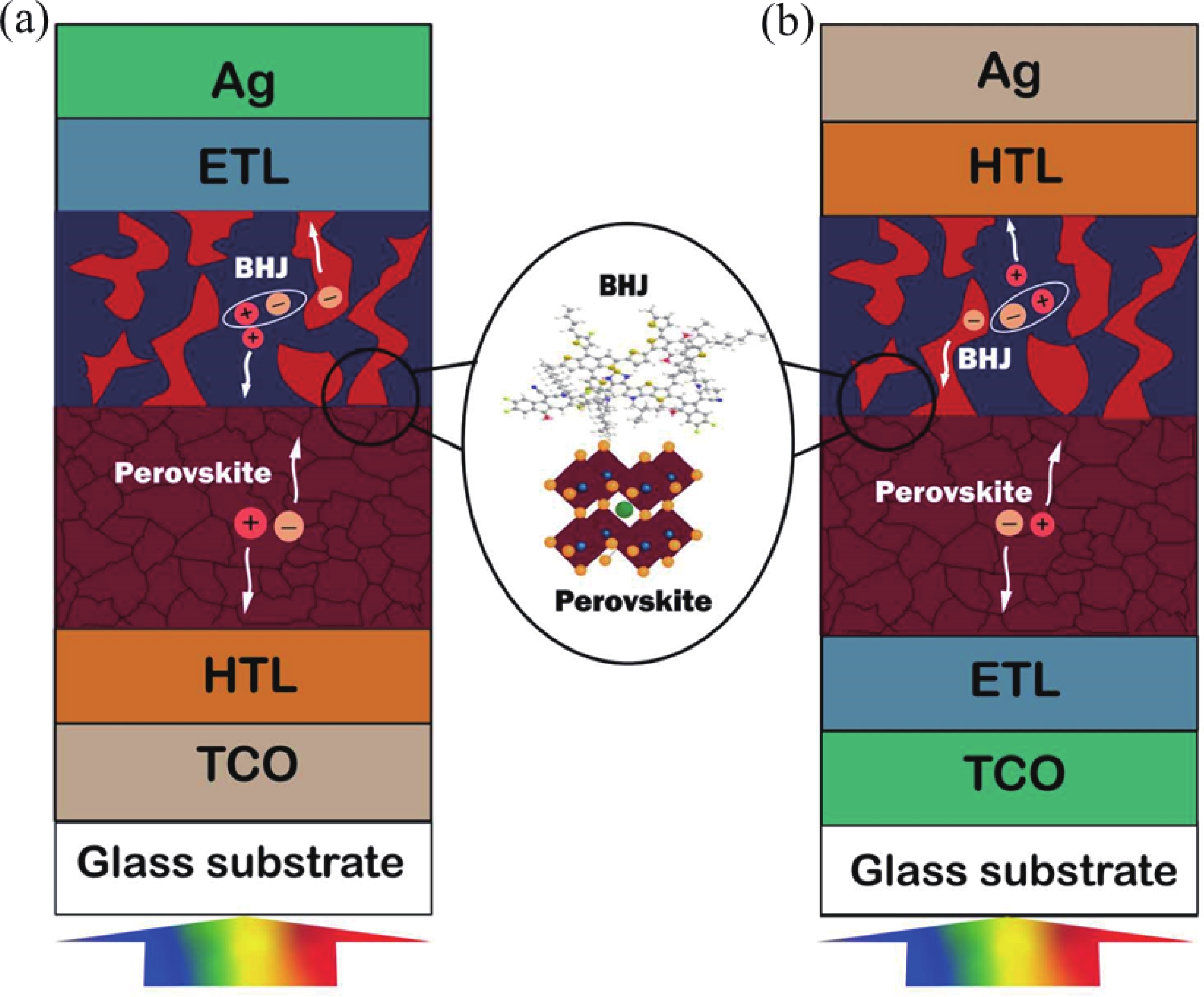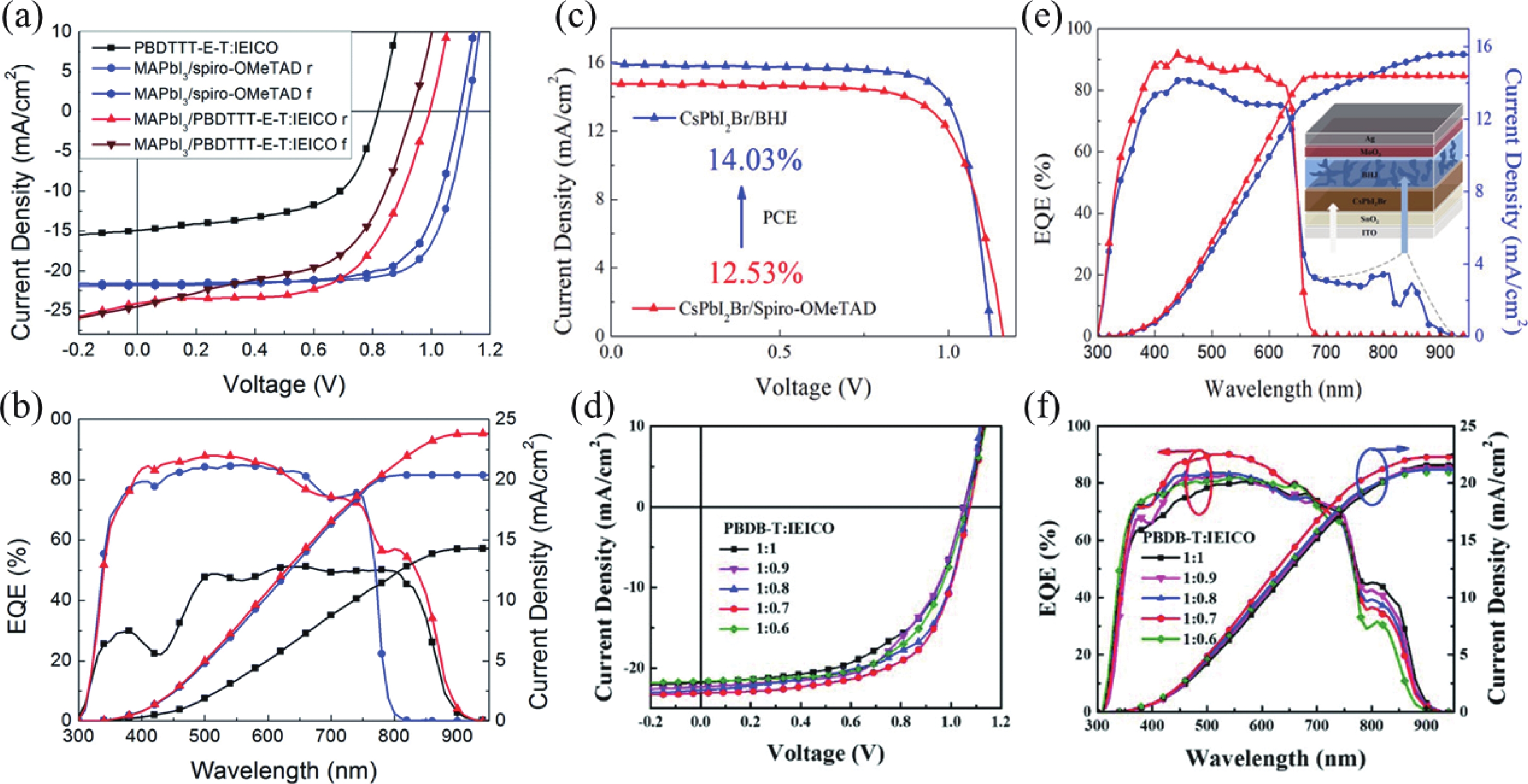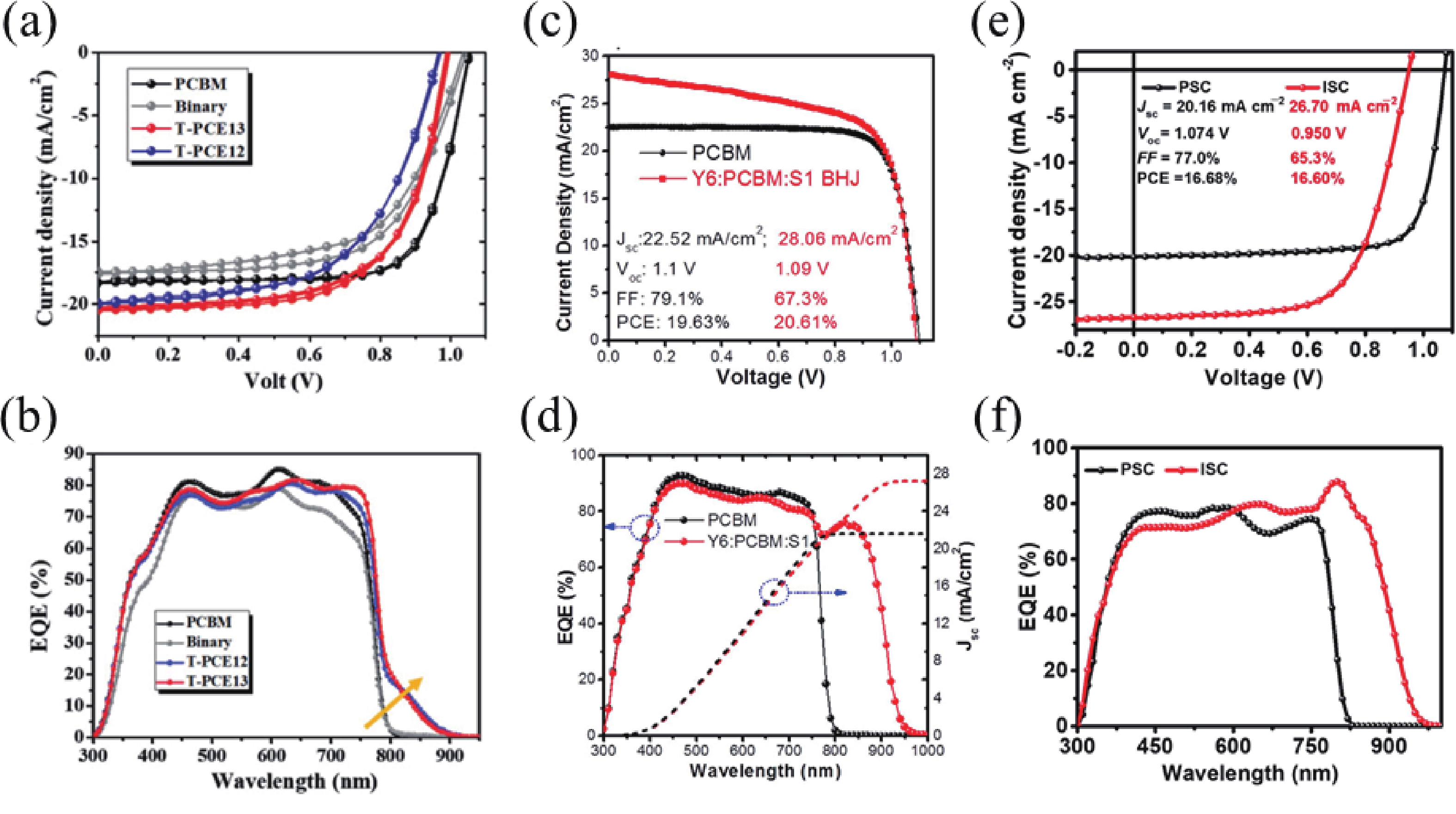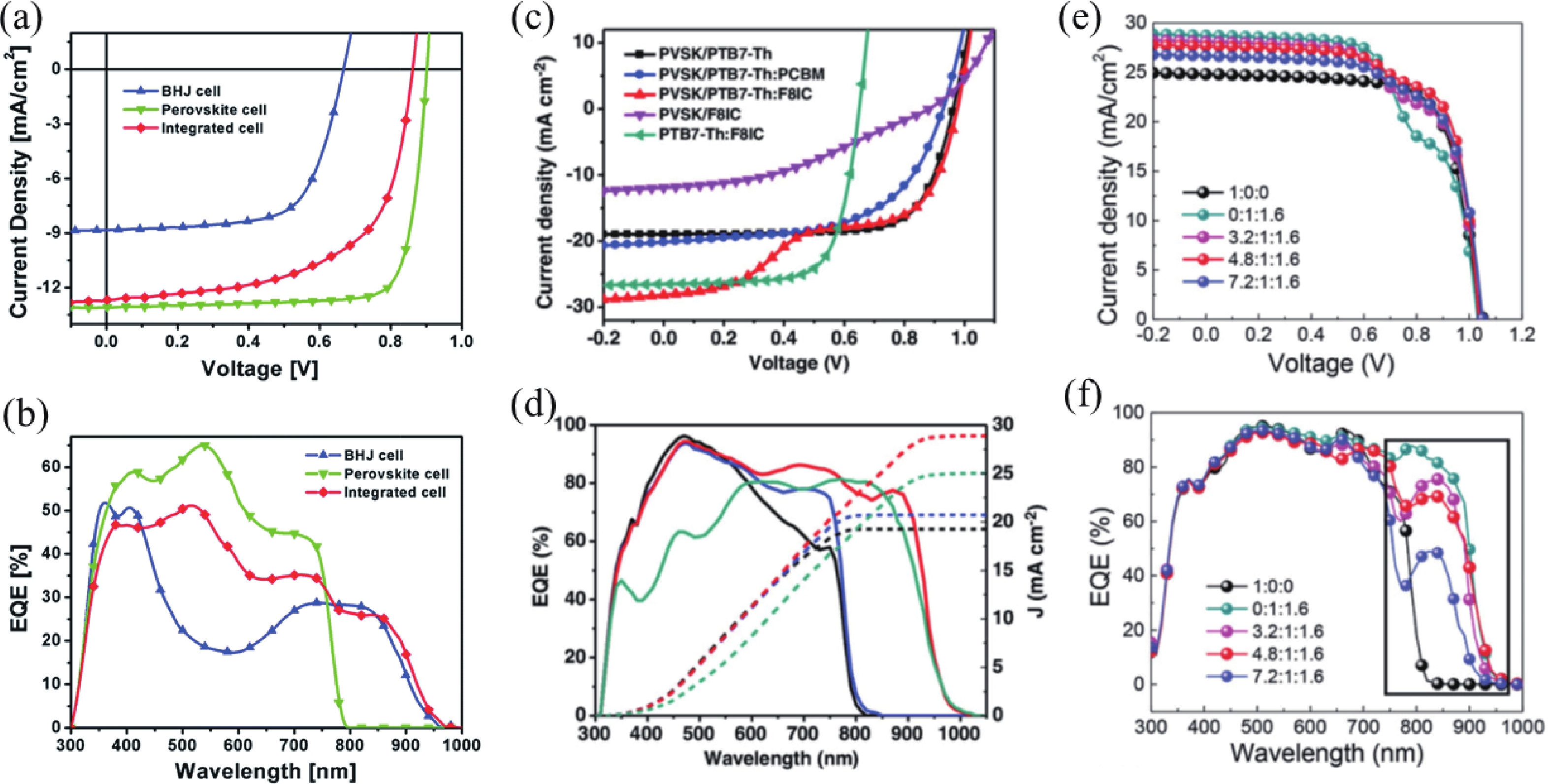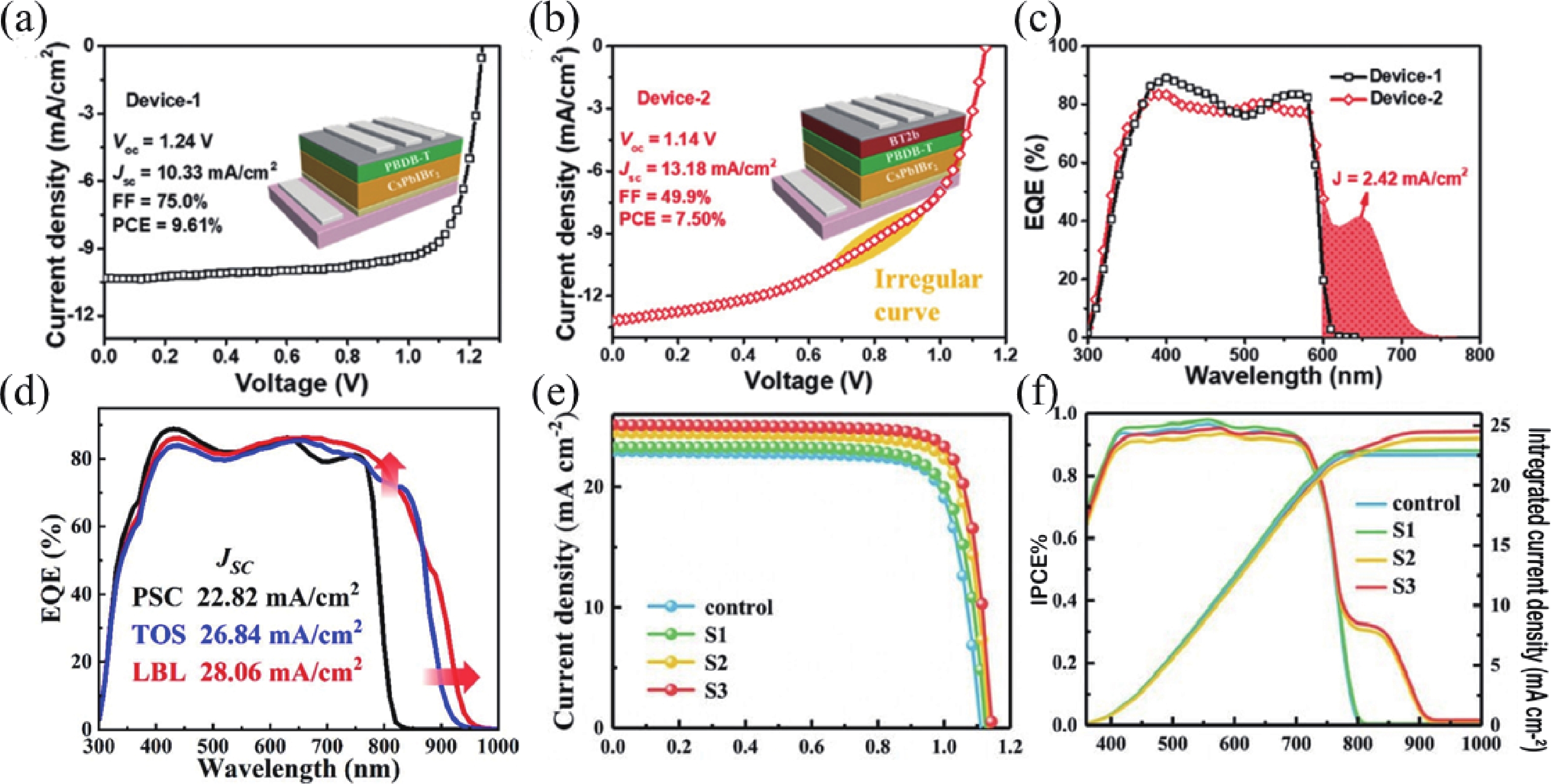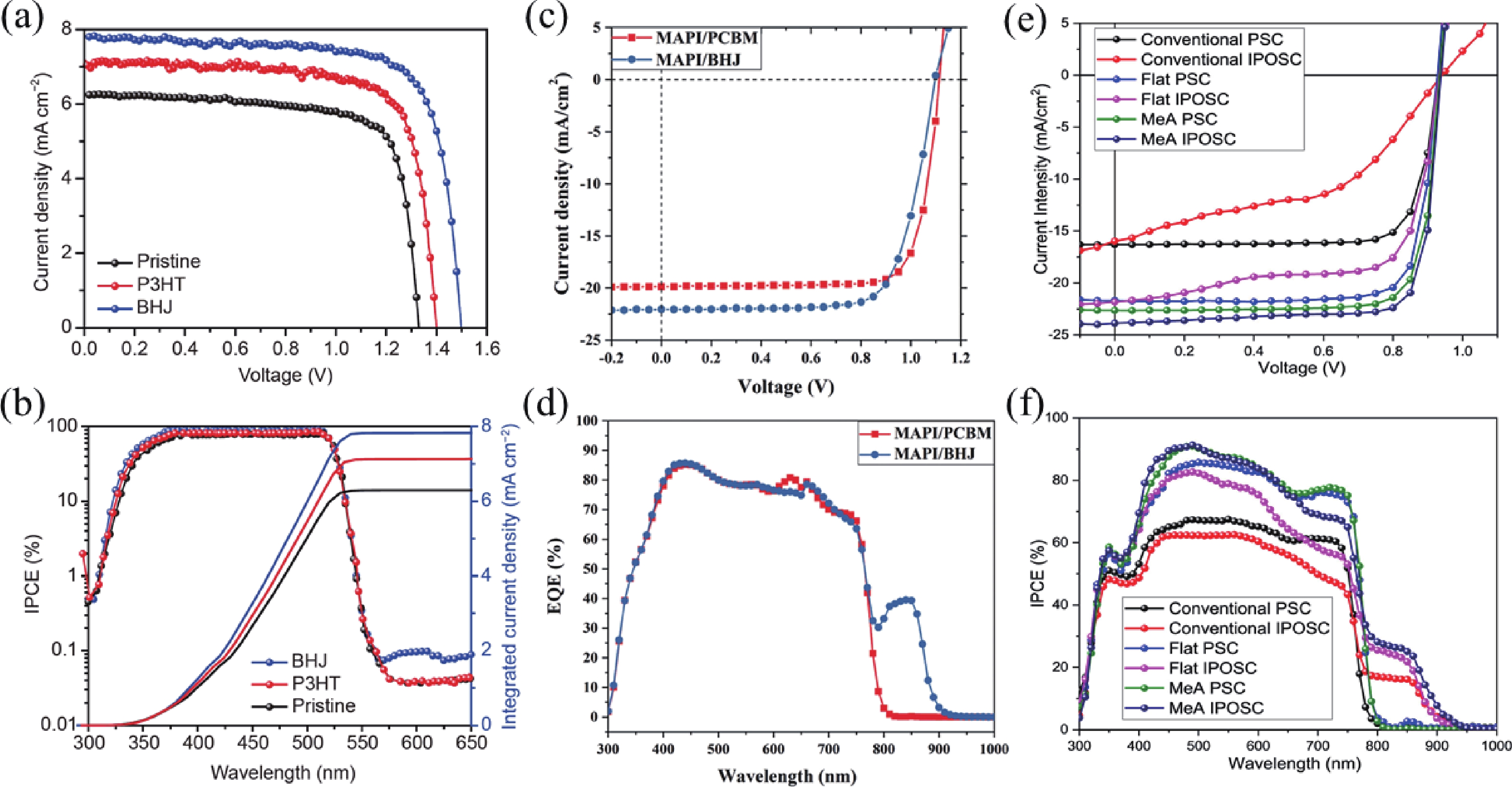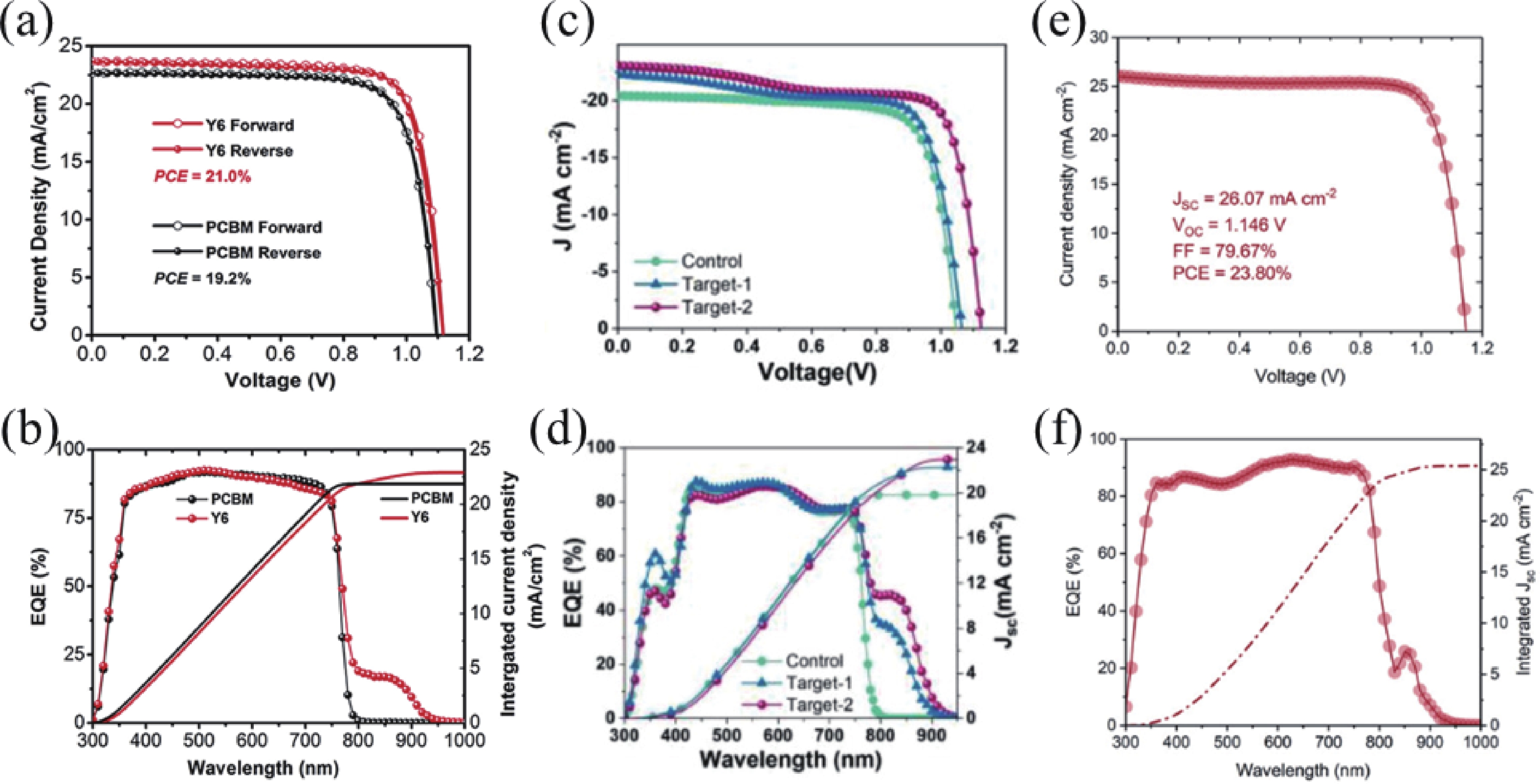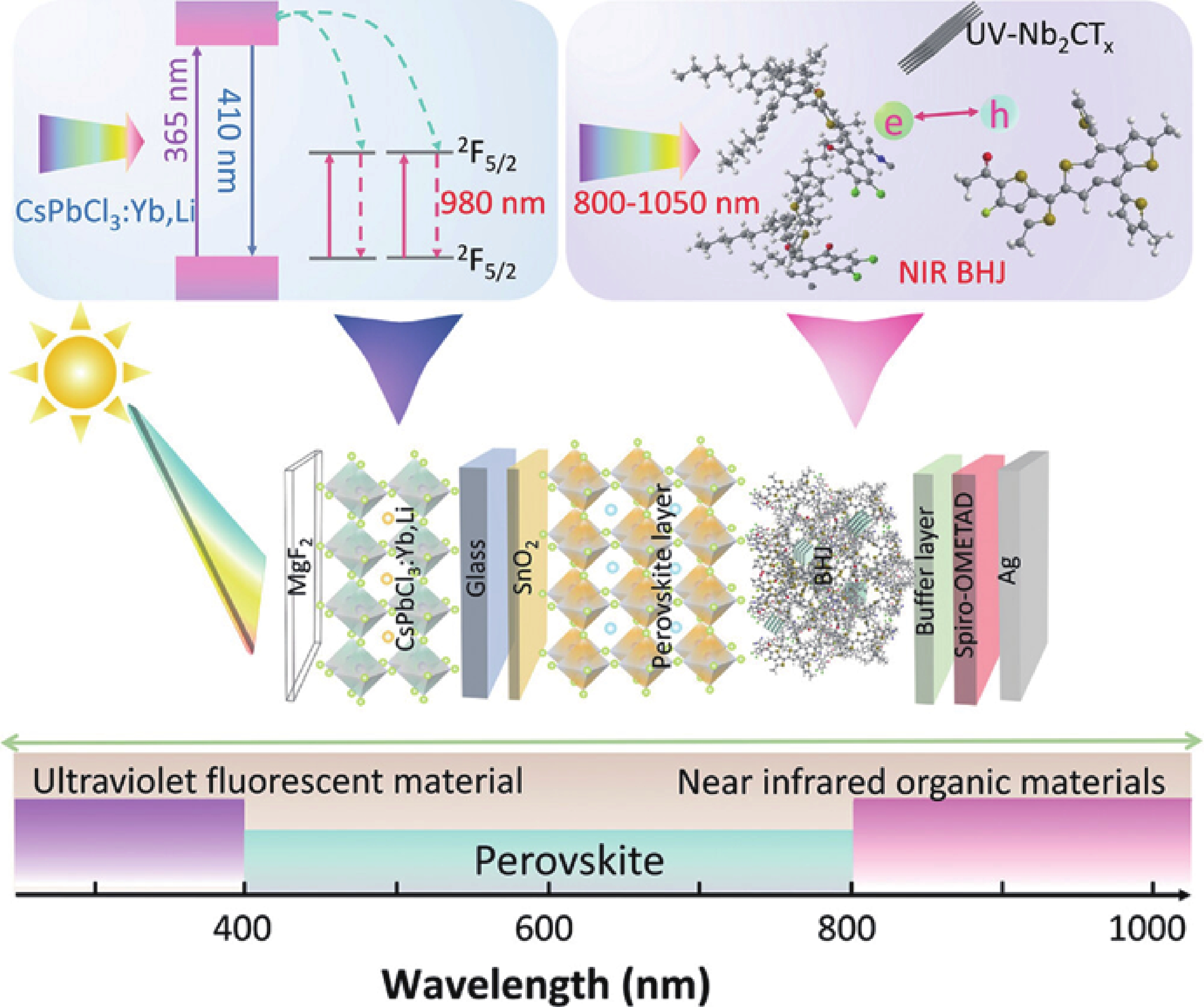| Citation: |
Zia Ur Rehman, Francesco Lamberti, Zhubing He. The evolution of integrated perovskite-organic solar cells: from early challenges to cutting-edge material innovations[J]. Journal of Semiconductors, 2025, 46(5): 051802. doi: 10.1088/1674-4926/24100034
****
Z U Rehman, F Lamberti, and Z B He, The evolution of integrated perovskite-organic solar cells: from early challenges to cutting-edge material innovations[J]. J. Semicond., 2025, 46(5), 051802 doi: 10.1088/1674-4926/24100034
|
The evolution of integrated perovskite-organic solar cells: from early challenges to cutting-edge material innovations
DOI: 10.1088/1674-4926/24100034
CSTR: 32376.14.1674-4926.24100034
More Information-
Abstract
Integrated perovskite-organic solar cells (IPOSCs) offer a promising hybrid approach that combines the advantages of perovskite and organic solar cells, enabling efficient photon absorption across a broad spectrum with a simplified architecture. However, challenges such as limited charge mobility in organic bulk heterojunction (BHJ) layers, and energy-level mismatch at the perovskite/BHJ interface still sustain. Recent advancements in non-fullerene acceptors (NFAs), interfacial engineering, and emerging materials have improved charge transfer/transport, and overall power conversion efficiency (PCE) of IPOSCs. This review explores key developments in IPOSCs, focusing on low-bandgap materials for near-infrared absorption, energy alignment optimization, and strategies to enhance photocurrent density and device performance. Future innovations in material selection and device architecture will be crucial for further improving the efficiency of IPOSCs, bringing them closer to practical application in next-generation photovoltaic technologies. -
References
[1] Kazak T. European green deal. 2022[2] Abidin H S. The rights of indigenous peoples in nationally determined contributions. 2023[3] Xinhua News. China's Carbon Neutrality Pledge. 2020[4] Jeong J, Kim M, Seo J, et al. Pseudo-halide anion engineering for α-FAPbI3 perovskite solar cells. Nature, 2021, 592, 381 doi: 10.1038/s41586-021-03406-5[5] Li Z, Li B, Wu X, et al. Organometallic-functionalized interfaces for highly efficient inverted perovskite solar cells. Science, 2022, 376, 416 doi: 10.1126/science.abm8566[6] Tan Q, Li Z N, Luo G F, et al. Inverted perovskite solar cells using dimethylacridine-based dopants. Nature, 2023, 620, 545 doi: 10.1038/s41586-023-06207-0[7] Gong S K, Qu G P, Qiao Y, et al. A hot carrier perovskite solar cell with efficiency exceeding 27% enabled by ultrafast hot hole transfer with phthalocyanine derivatives. Energy Environ Sci, 2024, 17, 5080 doi: 10.1039/D4EE01839G[8] National Renewable Energy Laboratory, Best research-cell efficiencies chart.[9] Zheng Y T, Li Y R, Zhuang R S, et al. Towards 26% efficiency in inverted perovskite solar cells via interfacial flipped band bending and suppressed deep-level traps. Energy Environ Sci, 2024, 17, 1153 doi: 10.1039/D3EE03435F[10] Gong C, Li H Y, Xu Z Y, et al. Efficient and stable inverted perovskite solar cells enabled by homogenized PCBM with enhanced electron transport. Nat Commun, 2024, 15, 9154 doi: 10.1038/s41467-024-53283-5[11] Jiang Q, Zhu K. Rapid advances enabling high-performance inverted perovskite solar cells. Nat Rev Mater, 2024, 9, 399 doi: 10.1038/s41578-024-00678-x[12] Qu Z H, Zhao Y, Ma F, et al. Enhanced charge carrier transport and defects mitigation of passivation layer for efficient perovskite solar cells. Nat Commun, 2024, 15, 8620 doi: 10.1038/s41467-024-52925-y[13] Zhang X, Wu S F, Zhang H, et al. Advances in inverted perovskite solar cells. Nat Photonics, 2024 doi: 10.1038/s41566-024-01541-910.1038/s41566-024-01541-9[14] Green M A, Dunlop E D, Yoshita M, et al. Solar cell efficiency tables (Version 64). Prog Photovolt Res Appl, 2024, 32, 425 doi: 10.1002/pip.3831[15] Chen H Y, Zhang R, Chen X B, et al. A guest-assisted molecular-organization approach for >17% efficiency organic solar cells using environmentally friendly solvents. Nat Energy, 2021, 6, 1045 doi: 10.1038/s41560-021-00923-5[16] Zhu L, Zhang M, Xu J Q, et al. Single-junction organic solar cells with over 19% efficiency enabled by a refined double-fibril network morphology. Nat Mater, 2022, 21, 656 doi: 10.1038/s41563-022-01244-y[17] Fu J H, Fong P W K, Liu H, et al. 19.31% binary organic solar cell and low non-radiative recombination enabled by non-monotonic intermediate state transition. Nat Commun, 2023, 14, 1760 doi: 10.1038/s41467-023-37526-5[18] Fu J H, Yang Q G, Huang P H, et al. Rational molecular and device design enables organic solar cells approaching 20% efficiency. Nat Commun, 2024, 15, 1830 doi: 10.1038/s41467-024-46022-3[19] Zhu L, Zhang M, Zhou G Q, et al. Achieving 20.8% organic solar cells via additive-assisted layer-by-layer fabrication with bulk p-i-n structure and improved optical management. Joule, 2024, 8, 3153 doi: 10.1016/j.joule.2024.08.001[20] Liu K R, Jiang Y Y, Ran G L, et al. 19.7% efficiency binary organic solar cells achieved by selective core fluorination of nonfullerene electron acceptors. Joule, 2024, 8, 835 doi: 10.1016/j.joule.2024.01.005[21] Jiang Y Y, Sun S M, Xu R J, et al. Non-fullerene acceptor with asymmetric structure and phenyl-substituted alkyl side chain for 20.2% efficiency organic solar cells. Nat Energy, 2024, 9, 975 doi: 10.1038/s41560-024-01557-z[22] Zhu L, Zhang M, Zhou Z C, et al. Progress of organic photovoltaics towards 20% efficiency. Nat Rev Electr Eng, 2024, 1, 581 doi: 10.1038/s44287-024-00080-3[23] Jiang Y, Liu F, Zhu X. Single-junction organic solar cells with a power conversion efficiency of more than 20%. Nat Energy, 2024, 9, 930 doi: 10.1038/s41560-024-01558-y[24] Ren H, Chen J D, Zhang Y F, et al. 20.4% Power conversion efficiency from albedo-collecting organic solar cells under 0.2 albedo. Sci Adv, 2024, 10, eadp9439 doi: 10.1126/sciadv.adp9439[25] Sha W E I, Ren X G, Chen L Z, et al. The efficiency limit of CH3NH3PbI3 perovskite solar cells. Appl Phys Lett, 2015, 106, 221104 doi: 10.1063/1.4922150[26] Stolterfoht M, Wolff C M, Amir Y, et al. Approaching the fill factor Shockley−Queisser limit in stable, dopant-free triple cation perovskite solar cells. Energy Environ Sci, 2017, 10, 1530 doi: 10.1039/C7EE00899F[27] Park N G, Segawa H. Research direction toward theoretical efficiency in perovskite solar cells. ACS Photonics, 2018, 5, 2970 doi: 10.1021/acsphotonics.8b00124[28] Ehrler B, Alarcón-Lladó E, Tabernig S W, et al. Photovoltaics reaching for the shockley−queisser limit. ACS Energy Lett, 2020, 5, 3029 doi: 10.1021/acsenergylett.0c01790[29] Wang K, Zheng L Y, Hou Y C, et al. Overcoming Shockley-Queisser limit using halide perovskite platform? Joule, 2022, 6, 756 doi: 10.1016/j.joule.2022.01.00910.1016/j.joule.2022.01.009[30] Yang Y, Chen Q, Hsieh Y T, et al. Multilayer transparent top electrode for solution processed perovskite/Cu(In, Ga)(Se, S)2 four terminal tandem solar cells. ACS Nano, 2015, 9, 7714 doi: 10.1021/acsnano.5b03189[31] Han Q F, Hsieh Y T, Meng L, et al. High-performance perovskite/Cu(In, Ga)Se2 monolithic tandem solar cells. Science, 2018, 361, 904 doi: 10.1126/science.aat5055[32] Liu Y, Renna L A, Bag M, et al. High efficiency tandem thin-perovskite/polymer solar cells with a graded recombination layer. ACS Appl Mater Interfaces, 2016, 8, 7070 doi: 10.1021/acsami.5b12740[33] Eperon G E, Leijtens T, Bush K A, et al. Perovskite-perovskite tandem photovoltaics with optimized band gaps. Science, 2016, 354, 861 doi: 10.1126/science.aaf9717[34] Wang Z Y, Song Z N, Yan Y F, et al. Perovskite—a perfect top cell for tandem devices to break the S−Q limit. Adv Sci, 2019, 6, 1801704 doi: 10.1002/advs.201801704[35] Chen C C, Bae S H, Chang W H, et al. Perovskite/polymer monolithic hybrid tandem solar cells utilizing a low-temperature, full solution process. Mater Horiz, 2015, 2, 203 doi: 10.1039/C4MH00237G[36] Torabi N, Behjat A, Zhou Y H, et al. Progress and challenges in perovskite photovoltaics from single- to multi-junction cells. Mater Today Energy, 2019, 12, 70 doi: 10.1016/j.mtener.2018.12.009[37] Yu Z H, Yang Z B, Ni Z Y, et al. Simplified interconnection structure based on C60/SnO2-x for all-perovskite tandem solar cells. Nat Energy, 2020, 5, 657 doi: 10.1038/s41560-020-0657-y[38] Wali Q, Elumalai N K, Iqbal Y, et al. Tandem perovskite solar cells. Renew Sustain Energy Rev, 2018, 84, 89 doi: 10.1016/j.rser.2018.01.005[39] Guo Q, Wang C Y, Hayat T, et al. Recent advances in perovskite/organic integrated solar cells. Rare Met, 2021, 40, 2763 doi: 10.1007/s12598-020-01703-y[40] Lee J. Perovskite and organic bulk heterojunction integrated solar cells: A mini review. J Korean Phys Soc, 2023, 82, 229 doi: 10.1007/s40042-023-00733-w[41] Hong S, Lee J. Recent advances and challenges toward efficient perovskite/organic integrated solar cells. Energies, 2022, 16, 266 doi: 10.3390/en16010266[42] Dong S Q, Liu Y S, Hong Z R, et al. Unraveling the high open circuit voltage and high performance of integrated perovskite/organic bulk-heterojunction solar cells. Nano Lett, 2017, 17, 5140 doi: 10.1021/acs.nanolett.7b02532[43] Shi Z C, Zhou D L, Zhuang X M, et al. Full-spectral response perovskite solar cells through integration of MXene modified near-infrared organic heterojunction and waveguide-structure quantum-cutting down-converter. Adv Energy Mater, 2024, 14, 2303735 doi: 10.1002/aenm.202303735[44] Liu Y S, Chen Y S. Integrated perovskite/bulk-heterojunction organic solar cells. Adv Mater, 2020, 32, 1805843 doi: 10.1002/adma.201805843[45] Liu Y S, Hong Z R, Chen Q, et al. Integrated perovskite/bulk-heterojunction toward efficient solar cells. Nano Lett, 2015, 15, 662 doi: 10.1021/nl504168q[46] Cheng M, Chen C, Aitola K, et al. Highly efficient integrated perovskite solar cells containing a small molecule-PC70BM bulk heterojunction layer with an extended photovoltaic response up to 900 nm. Chem Mater, 2016, 28, 8631 doi: 10.1021/acs.chemmater.6b03564[47] Gao K, Zhu Z L, Xu B, et al. Highly efficient porphyrin-based OPV/perovskite hybrid solar cells with extended photoresponse and high fill factor. Adv Mater, 2017, 29, 1703980 doi: 10.1002/adma.201703980[48] Guo Q, Liu H, Shi Z Z, et al. Efficient perovskite/organic integrated solar cells with extended photoresponse to 930 nm and enhanced near-infrared external quantum efficiency of over 50. Nanoscale, 2018, 10, 3245 doi: 10.1039/C7NR07933H[49] Guo Q, Bai Y M, Lang K, et al. Expanding the light harvesting of CsPbI2Br to near infrared by integrating with organic bulk heterojunction for efficient and stable solar cells. ACS Appl Mater Interfaces, 2019, 11, 37991 doi: 10.1021/acsami.9b14957[50] Wang C Y, Bai Y M, Guo Q, et al. Enhancing charge transport in an organic photoactive layer via vertical component engineering for efficient perovskite/organic integrated solar cells. Nanoscale, 2019, 11, 4035 doi: 10.1039/C8NR09467E[51] Zhao Y Y, Xu H Z, Wang Y D, et al. 10.34%-efficient integrated CsPbBr3/bulk-heterojunction solar cells. J Power Sources, 2019, 440, 227151 doi: 10.1016/j.jpowsour.2019.227151[52] Wu Y J, Gao Y B, Zhuang X M, et al. Highly efficient near-infrared hybrid perovskite solar cells by integrating with a novel organic bulk-heterojunction. Nano Energy, 2020, 77, 105181 doi: 10.1016/j.nanoen.2020.105181[53] Chen C I, Wu S F, Lu Y, et al. Enhanced near-infrared photoresponse of inverted perovskite solar cells through rational design of bulk-heterojunction electron-transporting layers. Adv Sci, 2019, 6, 1901714 doi: 10.1002/advs.201901714[54] Chen W, Sun H L, Hu Q, et al. High short-circuit current density via integrating the perovskite and ternary organic bulk heterojunction. ACS Energy Lett, 2019, 4, 2535 doi: 10.1021/acsenergylett.9b01964[55] Liao Q G, Sun H L, Li B L, et al. 26 mA cm-2 JSC achieved in the integrated solar cells. Sci Bull, 2019, 64, 1747 doi: 10.1016/j.scib.2019.10.005[56] Zuo C T, Ding L M. Bulk heterojunctions push the photoresponse of perovskite solar cells to 970 nm. J Mater Chem A, 2015, 3, 9063 doi: 10.1039/C4TA04482G[57] Ye L, Fan B H, Zhang S Q, et al. Perovskite-polymer hybrid solar cells with near-infrared external quantum efficiency over 40%. Sci China Mater, 2015, 58, 953 doi: 10.1007/s40843-015-0102-x[58] Kim J, Kim G, Back H, et al. High-performance integrated perovskite and organic solar cells with enhanced fill factors and near-infrared harvesting. Adv Mater, 2016, 28, 3159 doi: 10.1002/adma.201504555[59] Zhang M Y, Li T F, Yu J D, et al. Integrated perovskite/organic photovoltaics with ultrahigh photocurrent and photoresponse approaching 1000 nm. Sol RRL, 2020, 4, 2000140 doi: 10.1002/solr.202000140[60] Gao Y, Xu W Z, Zhang S W, et al. Double cascading charge transfer at integrated perovskite/organic bulk heterojunctions for extended near-infrared photoresponse and enhanced photocurrent. Small, 2022, 18, 2106083 doi: 10.1002/smll.202106083[61] Chen W J, Li D, Chen S S, et al. Spatial distribution recast for organic bulk heterojunctions for high-performance all-inorganic perovskite/organic integrated solar cells. Adv Energy Mater, 2020, 10, 2000851 doi: 10.1002/aenm.202000851[62] He X, Xu T Y, Zhang X X, et al. Enhancing photoresponse and photocurrent of integrated perovskite/organic solar cells via layer-by-layer processing. ACS Appl Energy Mater, 2023, 6, 981 doi: 10.1021/acsaem.2c03425[63] He L, Zhang H T, Zhang D Z, et al. Structure optimization and passivation strategy toward efficient integrated perovskite/pseudo-planar heterojunction solar cells. Adv Funct Mater, 2024, 34, 2403020 doi: 10.1002/adfm.202403020[64] Daboczi M, Kim J, Lee J, et al. Towards efficient integrated perovskite/organic bulk heterojunction solar cells: Interfacial energetic requirement to reduce charge carrier recombination losses. Adv Funct Mater, 2020, 30, 2001482 doi: 10.1002/adfm.202001482[65] Liu Y L, Park S H, Kim J. Efficient integrated perovskite/organic solar cells via interdigitated interfacial charge transfer. ACS Appl Mater Interfaces, 2023, 15, 34742 doi: 10.1021/acsami.3c04032[66] Wang D, Li W J, Li R S, et al. High-efficiency carbon-based CsPbIBr2 solar cells with interfacial energy loss suppressed by a thin bulk-heterojunction layer. Sol RRL, 2021, 5, 2100375 doi: 10.1002/solr.202100375[67] Du J, Duan J L, Duan Y Y, et al. Tailoring organic bulk-heterojunction for charge extraction and spectral absorption in CsPbBr3 perovskite solar cells. Sci China Mater, 2021, 64, 798 doi: 10.1007/s40843-020-1499-8[68] Shi Z C, Zhou D L, Zhuang X M, et al. Light management through organic bulk heterojunction and carrier interfacial engineering for perovskite solar cells with 23.5% efficiency. Adv Funct Mater, 2022, 32, 2203873 doi: 10.1002/adfm.202203873[69] Cai Z Z, Ma X Y, Cai J F, et al. Suppressing interface charge recombination for efficient integrated perovskite/organic bulk-heterojunction solar cells. J Power Sources, 2022, 541, 231665 doi: 10.1016/j.jpowsour.2022.231665[70] Hu Q, Chen W, Yang W Q, et al. Improving efficiency and stability of perovskite solar cells enabled by A near-infrared-absorbing moisture barrier. Joule, 2020, 4, 1575 doi: 10.1016/j.joule.2020.06.007[71] Wang T, Dong Y X, Guo J H, et al. Integrated quasi-2D perovskite/organic solar cells with efficiency over 19% promoted by interface passivation. Adv Funct Mater, 2021, 31, 2107129 doi: 10.1002/adfm.202107129[72] Wu S F, Li Z, Zhang J, et al. Low-bandgap organic bulk-heterojunction enabled efficient and flexible perovskite solar cells. Adv Mater, 2021, 33, 2105539 doi: 10.1002/adma.202105539[73] Zhou X Y, Zhang L Z, Yu J W, et al. Integrated ideal-bandgap perovskite/bulk-heterojunction solar cells with efficiencies > 24%. Adv Mater, 2022, 34, 2205809 doi: 10.1002/adma.202205809[74] Guo Q, Dai Z, Dong C Q, et al. 17.3% efficiency CsPbI2Br solar cells by integrating a Near-infrared absorbed organic Bulk-heterojunction layer. Chem Eng J, 2023, 461, 142025 doi: 10.1016/j.cej.2023.142025[75] Chen P, Ma X Y, Wang Z Y, et al. Revealing the impact of thermal annealing on the perovskite/organic bulk heterojunction interface in photovoltaic devices. Phys Chem Chem Phys, 2024, 26, 14874 doi: 10.1039/D4CP00849A[76] Weng N, Liao Q G, Li X, et al. Reducing interfacial losses in solution-processed integrated perovskite-organic solar cells. ACS Appl Mater Interfaces, 2024, 16, 10170 doi: 10.1021/acsami.3c18471[77] Wu Y J, Ding N, Zhang Y H, et al. Toward broad spectral response inverted perovskite solar cells: Insulating quantum-cutting perovskite nanophosphors and multifunctional ternary organic bulk-heterojunction. Adv Energy Mater, 2022, 12, 2200005 doi: 10.1002/aenm.202200005[78] Li X L, Huang Z D, Shuck C E, et al. MXene chemistry, electrochemistry and energy storage applications. Nat Rev Chem, 2022, 6, 389 doi: 10.1038/s41570-022-00384-8 -
Proportional views





 Zia Ur Rehman got his bachelor’s degree in 2014 from Government College University Faisalabad, Pakistan and his master’s degree in 2017 from Quaid-i-Azam University Islamabad, Pakistan. After that he received his doctoral degree in 2024 from University of Science and Technology, Korea. Now he is a postdoc at Southern University of Science and Technology in China. His current research focuses on organic solar cells.
Zia Ur Rehman got his bachelor’s degree in 2014 from Government College University Faisalabad, Pakistan and his master’s degree in 2017 from Quaid-i-Azam University Islamabad, Pakistan. After that he received his doctoral degree in 2024 from University of Science and Technology, Korea. Now he is a postdoc at Southern University of Science and Technology in China. His current research focuses on organic solar cells. Francesco Lamberti is now an Assistant Professor at the University of Padova and specializes in nanofabrication, biomaterials, electrochemistry, and solar cell study. During his PhD and early postdoc at the University of Padova, he established an electrochemical lab and secured funding for advanced equipment. At the Italian Institute of Technology, he gained expertise in perovskite solar cells and advanced characterization techniques. Returning to Padova, he worked on spray-coating technologies and photoelectrode development. As R & D Director at BeyondSun PV in China, he was engaged in developing third-generation and tandem perovskite solar cells.
Francesco Lamberti is now an Assistant Professor at the University of Padova and specializes in nanofabrication, biomaterials, electrochemistry, and solar cell study. During his PhD and early postdoc at the University of Padova, he established an electrochemical lab and secured funding for advanced equipment. At the Italian Institute of Technology, he gained expertise in perovskite solar cells and advanced characterization techniques. Returning to Padova, he worked on spray-coating technologies and photoelectrode development. As R & D Director at BeyondSun PV in China, he was engaged in developing third-generation and tandem perovskite solar cells. Zhubing He is now a full professor at Department of Materials Science and Engineering in Southern University of Science and Technology (SUSTech). He obtained his Ph.D. degree in Applied Physics and Materials Science from City University of Hong Kong in 2009. He joined in SUSTech as an associate professor at 2012, after working as a research scientist to develop HIT photovoltaics in industry. Currently, he focuses on interface science and engineering in solar energy conversion technologies, including heterojunction solar cells, phase change materials, nanophotonics for solar energy conversion.
Zhubing He is now a full professor at Department of Materials Science and Engineering in Southern University of Science and Technology (SUSTech). He obtained his Ph.D. degree in Applied Physics and Materials Science from City University of Hong Kong in 2009. He joined in SUSTech as an associate professor at 2012, after working as a research scientist to develop HIT photovoltaics in industry. Currently, he focuses on interface science and engineering in solar energy conversion technologies, including heterojunction solar cells, phase change materials, nanophotonics for solar energy conversion.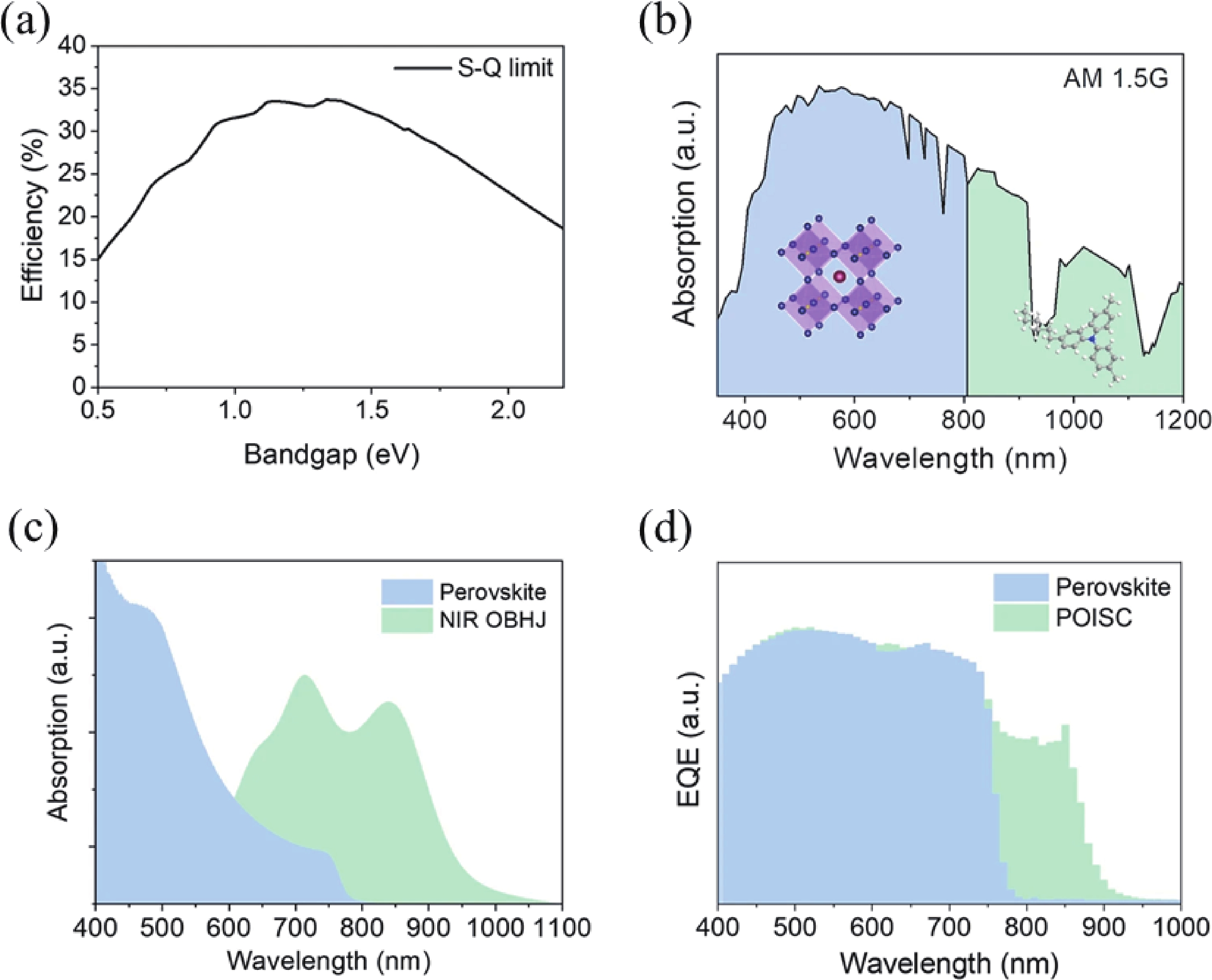
 DownLoad:
DownLoad:
